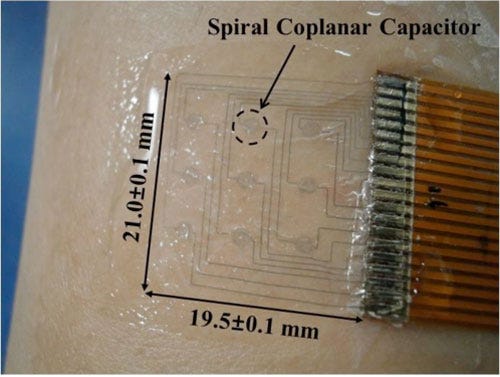Goose Bump Detector Can Gauge Emotion
July 7, 2014
A team of scientists at KAIST in Daejeon, South Korea, has developed a flexible, wearable polymer sensor that can directly measure the degree and occurrence of piloerection, commonly known as goose bumps, on the skin.
They have published their work, "A Flexible Skin Piloerection Monitoring Sensor" (Kim, et al,) in the journal Applied Physics Letters.
|
The Goose Bump Detector: a skin piloerection monitoring sensor (Courtesy Young-Ho Cho/KAIST) |
The researchers' 20 × 20 mm sensor directly measures the degree and occurrence of piloerection, caused by sudden changes in body temperature or emotional states.
The technology is based on a coplanar capacitor. It detects goose bumps by virtue of a simple linear relation between the deformation of the sensor and the decrease of the capacitance.
"We found that the height of the goose bump and the piloerection duration can be deduced by analyzing the obtained capacitance change trace," explained Young-Ho Cho.
Refresh your medical device industry knowledge at MEDevice San Diego, September 10-11, 2014. |
While more work still needs to be done to correlate such physical measurements with emotional states, the authors say the work suggests that quantitatively monitoring goose bumps in real-time as an indicator of human physical or emotional status is possible.
"In the future, human emotions will be regarded like any typical biometric information, including body temperature or blood pressure," Cho said, which could pave the way for personalized advertising, music streams or other services informed by direct access to the emotions of the end user.
Using microfabrication technology, Cho and colleagues built the sensor from a conductive polymer, PEDOT:PSS, for the capacitors. These capacitors were embedded in a silicon substrate via a multi-step spin-coating process, giving them a spiral shape and coplanar structure. This gave them high capacitive density and high deformability, while remaining only 1.2 ?m thick.
The silicon substrate was selected due to its biocompatibility and high degree of flexibility relative to human skin. It also has high thermal and photo stability, which allows the embedded polymer devices to maintain their performance in diverse conditions.
The researchers attached these sensors to the inside of a subject's forearm and had him grasp a container of ice cubes to induce a sudden cold shock. This stimulated piloerection, deforming the sensors and causing their capacitance to notably decrease.
The authors say their future work includes scaling down the signal processing module and capacitance measurement system to be co-mounted on skin with the sensor.
Stephen Levy is a contributor to Qmed and MPMN.
Like what you're reading? Subscribe to our daily e-newsletter.
About the Author(s)
You May Also Like


.png?width=300&auto=webp&quality=80&disable=upscale)
